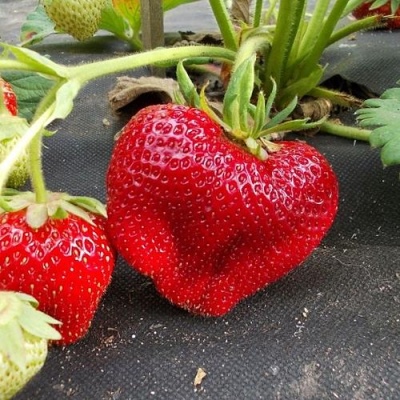
- Authors: USA
- Name synonyms: Gurney's Giant
- Taste: sweet
- The size: very large
- Weight: 35-40 gr
- Yield rate: high
- Yield: up to 1.5 kg per bush
- Ripening terms: early
- Appointment: fresh consumption
- Description of the bush: powerful, spreading, large
American Strawberry Giant Jorney is one of the elite large-fruited varieties that give bountiful yields. The culture also attracts attention with its delicious sweet taste with a pleasant sourness in the aftertaste and a rich strawberry aroma. The bushes are undemanding to care for, they can grow on poor soils. However, it is necessary to take into account some of the nuances in growing.
Description of the variety
Strawberry bushes grow powerful and spreading, on average plant height can reach 50 cm. Large foliage has a rich dark green color. Peduncles are formed on stable stalks.
Ripening terms
Early ripening variety. The first fruits can be enjoyed already at the beginning of June.
Yield
The Giant Jornea strawberry is a high-yielding variety. Up to 1.5 kg of aromatic berries can be harvested from one bush. With good care, the culture is capable of producing up to 3 kg of fruit per bush.
Berries and their taste
The berries grow very large. With competent agricultural technology, the weight of one fruit can reach 70-100 g. Strawberries of the main crop have a weight of 35-40 g. The variety does not tend to bear fruit with small berries. The shape of the fruit is round-conical.
Their taste is sweet with a rich strawberry aroma. The present slight sourness gives the taste a delicious aftertaste. The color of the berries ranges from red to dark red. Despite the fact that the pulp is very juicy and fleshy, the variety easily tolerates transportation and retains its presentation for up to 4 days.
Large strawberries are mainly consumed fresh, smaller ones are used in the preparation of jams, preserves, compotes, they also serve as an excellent decoration on cakes, pastries, pies.
Growing features
The soil should be constantly moist, but not waterlogged. Lack of moisture slows down the development of bushes and reduces yields. Excess water leads to an increase in the occurrence of fungal and bacterial infections, which reduce the protective functions of the variety.
Due to the fact that the bush grows very sprawling, the culture will need a large amount of nutrients for intensive growth. Top dressing is applied several times a year. The first is carried out in early spring, immediately after the snow melts. The soil is enriched with organic matter (rotted mullein or chicken droppings), as well as ammonium nitrate. This will enable the bushes to grow abundantly green mass.
When strawberries begin to bear fruit, they will need combined mineral fertilizers. In the fall, before the onset of frost, you need to feed the plants with organic matter. However, it is impossible to overfeed the bushes, this negatively affects the yield. And also regularly should be carried out loosening, weeding between the rows.




Site selection and soil preparation
Before you start planting a variety, you must first prepare the soil. It is dug up, weeds and roots are removed, humus or compost, sand, mineral fertilizers are added.
The best time for planting is autumn, early September. The site is chosen sunny, with a slight rise. Plants must be planted according to the scheme between the bushes 30 cm, between the rows 40 cm.The holes are dug to a depth of 20 cm.
The seedlings are carefully planted in the pits, carefully straightening the roots. Then the plants are covered with earth and watered abundantly. Seedlings must be planted with great care. The center of growth of the bush cannot be covered with soil. This can lead to rotting.
Strawberry Giant Jorney is able to grow even on the poorest of soils and under adverse conditions. In one place, the culture can effectively bear fruit for up to 5 years.

Pollination
Experienced gardeners advise planting another early variety, Big Boy, next to the Giant Jorney strawberries. The flowers of this plant have a more intense aroma, attract bees, which significantly increases the yield of both species.

One of the important techniques in strawberry care is feeding. Regular fertilization guarantees a rich harvest. There are several different ways to feed strawberries, and each of them is designed for a specific period of plant development. During flowering, fruiting and after it, feeding should be different.
Frost resistance and the need for shelter
A significant advantage of this variety is the ability to withstand both drought and severe frosts.

Diseases and pests
The variety has strong immunity. But in the case of improper watering or heavy rains, gray rot or other fungal infections may develop on the bushes. For preventive purposes, the culture is treated with fungicides in early spring, with the beginning of flowering and after harvesting. Affected berries and foliage must be burned.

Strawberries are often subject to many dangerous diseases that can seriously undermine their condition. Among the most common are powdery mildew, gray mold, brown spot, anthracnose and verticillosis. Before buying a variety, you need to inquire about its disease resistance.
Reproduction
Unfortunately, the variety forms few mustache, so culture is a rarity on the domestic market. If there are a large number of bushes, then the division of the bushes can be used for reproduction.
Despite this, the plant reproduces well by seeds. Planting material gives 100% germination. However, it should be noted that the seeds should be as fresh as possible. So you can get high quality seedlings and enjoy delicious fruits in the year of planting.



















































































